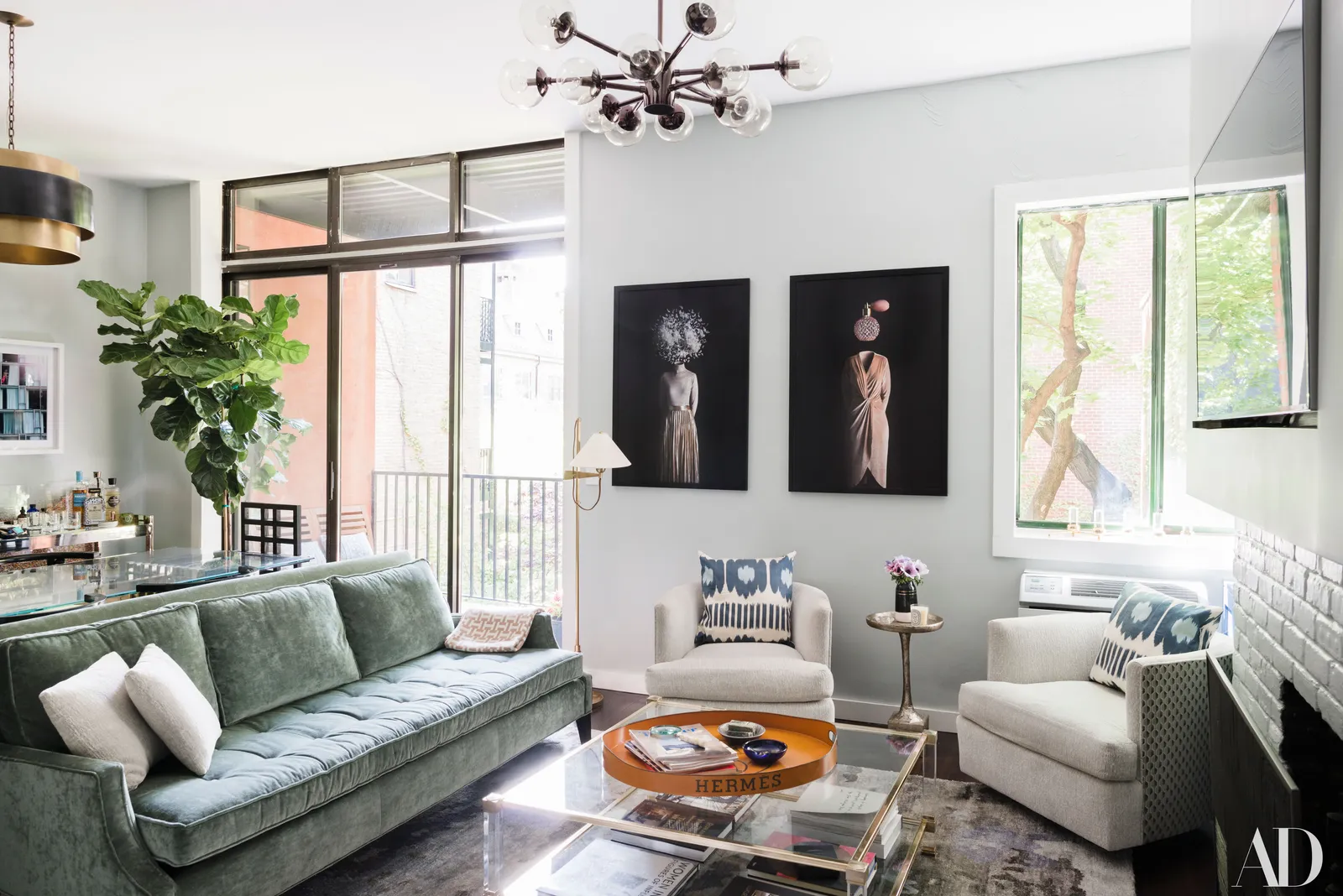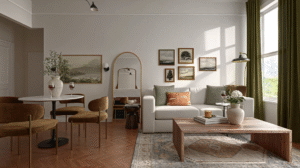Transforming Tiny Spaces into Stylish Havens
Decorating a small space can feel like solving a puzzle with half the pieces missing. Whether it’s a cozy studio apartment, a compact dorm room, or a snug corner of your home, limited square footage demands creativity and strategy. With the right approach, you can turn cramped quarters into a stylish, functional oasis that reflects your personality. Here are four essential tips—drawn from personal experience and expert insights—to make your small space feel bigger, brighter, and uniquely yours.
Tip 1: Embrace Multifunctional Furniture
Why Multifunctional Furniture is a Game-Changer
In a small space, every piece of furniture needs to pull double duty. Think of multifunctional furniture as the Swiss Army knife of interior design—versatile, practical, and space-saving. From sofa beds to storage ottomans, these pieces maximize utility without sacrificing style, making them perfect for tight quarters.
Top Picks for Multifunctional Furniture
- Sofa Beds: Ideal for studios, they serve as seating by day and a cozy bed by night.
- Storage Ottomans: These provide seating, a footrest, and hidden storage for blankets or books.
- Foldable Dining Tables: Expand for meals and collapse to free up floor space.
- Wall-Mounted Desks: Perfect for a home office that tucks away when not in use.
My Experience with a Murphy Bed
When I moved into my 400-square-foot apartment, I struggled to fit a bed and a living area. Enter the Murphy bed—a wall-mounted marvel that folds up to reveal a sleek desk. By day, I had a workspace for my freelance gigs; by night, a comfy bed. It was like living in a Transformer, and I loved how it made my space feel twice as big.
Where to Find Multifunctional Furniture
Check retailers like IKEA, West Elm, or Wayfair for affordable, stylish options. For custom pieces, local furniture makers on platforms like Etsy can craft solutions tailored to your space.
Tip 2: Use Light and Color Strategically
The Power of Light and Color
Light and color can make or break a small space. Bright, airy hues and clever lighting can trick the eye into seeing more room than there actually is. By choosing the right palette and lighting, you can create a sense of openness and warmth that feels inviting.
Best Colors for Small Spaces
- Soft Neutrals: Whites, creams, and light grays reflect light and make walls recede.
- Pastels: Pale blues or mint greens add personality without overwhelming.
- Bold Accents: A single vibrant wall or colorful decor can add depth without cluttering.
Lighting Tips for Ambiance and Illusion
- Natural Light: Keep windows unobstructed with sheer curtains to let sunlight flood in.
- Layered Lighting: Combine overhead lights, floor lamps, and table lamps for versatility.
- Mirrors: Place mirrors opposite windows to reflect light and create the illusion of space.
A Lesson from My Tiny Living Room
In my old apartment, the living room was a dim 10×10-foot box. I painted the walls a crisp white and hung a large mirror across from the window. The room instantly felt brighter and bigger. Adding a slim floor lamp with a warm bulb made evenings cozy without eating up floor space. It was like giving the room a facelift without touching the layout.
Tip 3: Maximize Vertical Space
Why Vertical Space is Your Secret Weapon
When floor space is scarce, look up! Walls are often underutilized in small spaces, but they offer prime real estate for storage and decor. By going vertical, you can keep your floors clear and make your space feel less cluttered.
Creative Ways to Use Vertical Space
- Wall Shelves: Install floating shelves for books, plants, or decorative items.
- Tall Bookcases: Slim, tall units provide storage without hogging floor space.
- Hanging Organizers: Use wall-mounted baskets for kitchen or bathroom essentials.
- Pegboards: Versatile for tools, accessories, or even kitchen utensils.
My Vertical Storage Success Story
In my tiny kitchen, counter space was nonexistent. I installed a pegboard on one wall, hanging pots, pans, and even a small spice rack. Not only did it free up my counters, but it also became a quirky focal point that guests always complimented. It was a $20 solution that felt like a million bucks.
Tools for Vertical Storage
For shelves and organizers, check The Container Store or Amazon. For DIY enthusiasts, Home Depot offers affordable materials like pegboards and brackets to build custom solutions.
Tip 4: Declutter and Curate with Intention
The Art of Decluttering
In a small space, less is truly more. Clutter can make even the most well-designed room feel chaotic, so curating your belongings is key. Focus on keeping items that serve a purpose or spark joy, and let go of the rest.
Steps to Declutter Effectively
- Assess Your Needs: Keep only essentials and items you love.
- Use the One-Year Rule: If you haven’t used it in a year, donate or sell it.
- Organize by Category: Tackle clothes, books, and kitchen items separately.
- Invest in Storage Solutions: Baskets, bins, and drawer dividers keep things tidy.
My Decluttering Journey
When I downsized to my current apartment, I had to part with half my wardrobe. It was tough—those old concert tees held memories! But using the one-year rule, I donated what I didn’t need and invested in slim hangers to organize my closet. The result? A space that felt calm and intentional, not like a storage unit.
Where to Donate or Sell Items
Donate to local charities like Goodwill or sell on platforms like eBay or Poshmark. For inspiration on minimalist living, check The Minimalists.
Comparison: Small Space Decorating Styles
| Style | Key Features | Best For | Challenges |
|---|---|---|---|
| Minimalist | Neutral tones, clean lines, sparse decor | Small studios, modern tastes | Can feel cold if not balanced |
| Bohemian | Bold colors, textures, eclectic pieces | Creative personalities | Risk of clutter in tight spaces |
| Scandinavian | Light colors, wood accents, cozy vibes | Cozy apartments, cold climates | Requires careful furniture scale |
| Industrial | Raw materials, exposed textures | Urban lofts, edgy aesthetics | Can feel stark without softening |
Each style can work in a small space, but Scandinavian and minimalist tend to be the most forgiving for beginners due to their focus on light and simplicity.
Pros and Cons of Decorating a Small Space
Pros
- Cost-Effective: Less space means fewer furnishings and lower decorating costs.
- Creative Freedom: Small spaces encourage innovative solutions and personal touches.
- Cozy Appeal: Intimate spaces feel warm and inviting with the right decor.
Cons
- Limited Storage: Finding room for essentials can be a constant challenge.
- Clutter Risk: Small spaces can feel chaotic without regular organization.
- Furniture Constraints: Large pieces often don’t fit, limiting options.
People Also Ask (PAA) Section
How can I make a small space look bigger?
Use light colors, mirrors, and multifunctional furniture to create the illusion of space. Keep clutter to a minimum and let natural light flow freely. Vertical storage and open shelving also help maintain an airy feel.
What are the best furniture pieces for small spaces?
Opt for multifunctional pieces like sofa beds, storage ottomans, and foldable tables. Wall-mounted desks and slim bookcases maximize space without sacrificing function. Look for furniture with clean lines to avoid visual clutter.
Where can I buy affordable decor for a small space?
Retailers like IKEA, Target, and Wayfair offer budget-friendly, space-saving furniture and decor. For unique finds, explore Etsy or thrift stores like Goodwill. Online marketplaces like Amazon also have a wide selection of organizers.
How do I declutter a small apartment?
Start by assessing what you truly need and use the one-year rule to let go of unused items. Organize by category, invest in storage solutions, and donate or sell excess belongings. Regular maintenance prevents clutter buildup.
Tools and Resources for Small Space Decorating
Best Tools for Planning Your Space
- RoomSketcher: A free app to create 2D and 3D floor plans for your space.
- Pinterest: Find inspiration for small space layouts and decor ideas.
- IKEA Place: An AR app to visualize furniture in your home before buying.
Where to Shop for Small Space Decor
- IKEA: Affordable, space-saving furniture and storage solutions.
- Target: Stylish decor and organizers for budget-conscious shoppers.
- West Elm: Higher-end pieces with a focus on modern, compact designs.
Transactional Tip: Start Small
If you’re on a budget, begin with one key piece—like a storage ottoman or a foldable table—and build from there. Check Wayfair’s clearance section for deals on multifunctional furniture to kickstart your project.
The Emotional Side of Small Space Living
Living in a small space isn’t just about logistics; it’s about mindset. I’ll admit, there were days when my tiny apartment felt like a cage. But once I embraced the challenge—painting walls, rearranging furniture, and letting go of stuff I didn’t need—it became a sanctuary. There’s something liberating about curating a space that’s entirely yours, where every item has a purpose or a story. It’s like editing your life to keep only the best parts.
FAQ Section
How do you decorate a small space on a budget?
Focus on affordable, multifunctional furniture from stores like IKEA or Target. Use paint and mirrors to brighten the space without breaking the bank. Thrift stores and online marketplaces like eBay can also yield unique, low-cost decor.
What colors make a small room look bigger?
Light colors like white, cream, and soft pastels reflect light and create an open feel. Avoid dark colors on all walls, but a single accent wall can add depth. Mirrors also enhance the effect of light hues.
How can I maximize storage in a small space?
Use vertical space with shelves, pegboards, and tall bookcases. Invest in storage furniture like ottomans or beds with built-in drawers. Declutter regularly to keep only essentials.
What are the best lighting options for small spaces?
Combine natural light with layered artificial lighting, including overhead fixtures, floor lamps, and table lamps. Mirrors opposite windows amplify light. Choose warm bulbs for a cozy ambiance.
Can I use bold decor in a small space?
Yes, but use it sparingly. A bold accent wall or colorful decor pieces can add personality without overwhelming. Balance bold elements with neutral tones to keep the space airy.
Conclusion: Small Space, Big Possibilities
Decorating a small space is like writing a haiku—it requires precision, creativity, and a touch of heart. By embracing multifunctional furniture, playing with light and color, maximizing vertical space, and decluttering with intention, you can transform even the tiniest nook into a home that feels spacious and soulful. Start small, experiment boldly, and let your space tell your story. Ready to make your small space shine? Grab a paintbrush, a storage ottoman, and let the magic begin.


